
Helene Kröller-Müller was a German art collector. She was one of the first European women to put together a major art collection. She is credited with being one of the first collectors to recognise the genius of Vincent van Gogh. She donated her entire collection to the Dutch people, along with her and her husband, Anton Kröller's, large forested country estate. Today it is the Kröller-Müller Museum and sculpture garden and Hoge Veluwe National Park, the largest national park in the Netherlands.

Dame Jocelyn Barbara Hepworth was an English artist and sculptor. Her work exemplifies Modernism and in particular modern sculpture. Along with artists such as Ben Nicholson and Naum Gabo, Hepworth was a leading figure in the colony of artists who resided in St Ives during the Second World War.

The Barbara Hepworth Museum and Sculpture Garden in St Ives, Cornwall preserves the 20th-century sculptor Barbara Hepworth's studio and garden much as they were when she lived and worked there. She purchased the site in 1949 and lived and worked there for 26 years until her death in a fire on the premises in 1975.
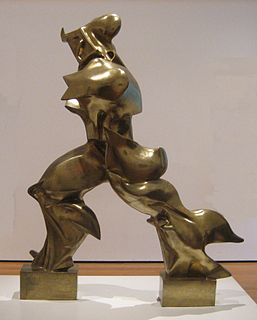
Unique Forms of Continuity in Space is a 1913 bronze Futurist sculpture by Umberto Boccioni. It is seen as an expression of movement and fluidity. The sculpture is depicted on the obverse of the Italian-issue 20 cent euro coin.
Denis Adeane Mitchell was an English abstract sculptor who worked mainly in bronze and wood. A prominent member of the St Ives group of artists, he worked as an assistant to Barbara Hepworth for many years.
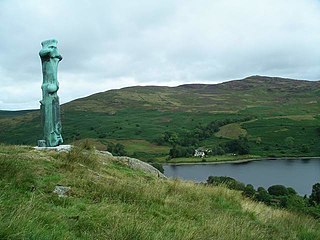
Upright Motive No. 1: Glenkiln Cross is a bronze sculpture by Henry Moore, cast in a number of copies in 1955–56. It was the first of a series of narrow vertical sculptures by Moore, who compared them to totem poles.
Elegy III is an abstract bronze sculpture, by Barbara Hepworth.

Sea Form (Atlantic) is a 1964 bronze sculpture by English artist Barbara Hepworth. It measures 204 cm × 107 cm × 73 cm.
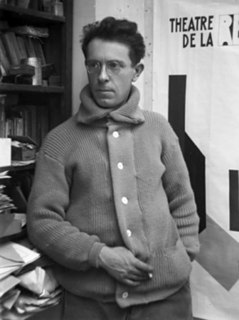
Joseph Csaky was a Hungarian avant-garde artist, sculptor, and graphic artist, best known for his early participation in the Cubist movement as a sculptor. Csaky was one of the first sculptors in Paris to apply the principles of pictorial Cubism to his art. A pioneer of modern sculpture, Csaky is among the most important sculptors of the early 20th century. He was an active member of the Section d'Or group between 1911 and 1914, and closely associated with Crystal Cubism, Purism, De Stijl, Abstract art, and Art Deco throughout the 1920s and 1930s.
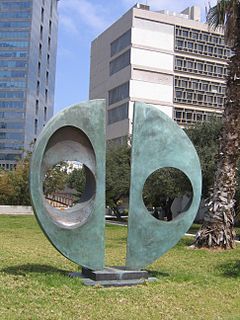
Two Forms is a bronze sculpture by Barbara Hepworth, designed in 1969. Six numbered copies were cast, plus one (0/6) retained by the sculptress. The sculpture's dimensions are 237 centimetres (93 in) by 234 centimetres (92 in) by 54 centimetres (21 in).

Modern sculpture is generally considered to have begun with the work of Auguste Rodin, who is seen as the progenitor of modern sculpture. While Rodin did not set out to rebel against the past, he created a new way of building his works. He "dissolved the hard outline of contemporary Neo-Greek academicism, and thereby created a vital synthesis of opacity and transparency, volume and void". Along with a few other artists in the late 19th century who experimented with new artistic visions in sculpture like Edgar Degas and Paul Gauguin, Rodin invented a radical new approach in the creation of sculpture. Modern sculpture, along with all modern art, "arose as part of Western society's attempt to come to terms with the urban, industrial and secular society that emerged during the nineteenth century".
Three Forms is an abstract sculpture by Barbara Hepworth, completed in 1935.
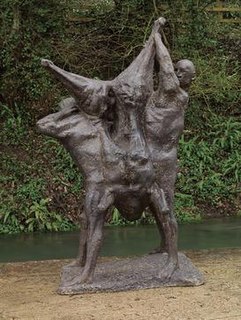
Ralph Brown was an English sculptor who came to national prominence in the late 1950s with his large-scale bronze Meat Porters, commissioned for Harlow New Town, Essex and is known for his sensual, figurative sculptures.

King and Queen is a bronze sculpture by Henry Moore, designed in 1952. It depicts two figures, one male and one female, seated beside each other on a bench, both facing slightly to the left. It is Moore's only sculpture depicting a single pair of adult figures. Moore's records suggest it was originally known as Two Seated Figures.

Winged Figure is a 1963 sculpture by British artist Barbara Hepworth. One of Hepworth's best known works, it has been displayed in London since April 1963, on Holles Street near the junction with Oxford Street, mounted on the south-east side of the John Lewis department store. It is estimated that the sculpture is seen by approximately 200 million people each year.
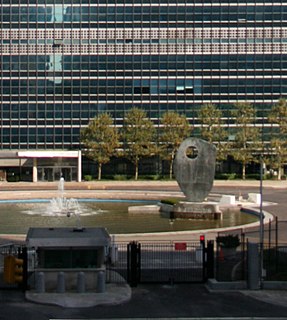
Single Form is a monumental bronze sculpture by the British artist Barbara Hepworth. It is her largest work, and one of her most prominent public commissions, displayed since 1964 in a circular water feature that forms a traffic island at the Headquarters of the United Nations in New York City, outside the United Nations Secretariat Building and the Dag Hammarskjöld Library. It is also the largest artwork cast by the Morris Singer foundry.

Locking Piece is a sculpture by Henry Moore. It comprises two interlocking forms holding a third element between them, on a bronze base. It is usually mounted on a separate plinth. The sculpture was created in 1962–1964, and bronze casts were made in 1964–1967.

Four-Square is a 4.3 metres (14 ft) high bronze sculpture by British artist Barbara Hepworth. It was cast in 1966 in an edition of 3+1. The four casts are displayed at the Barbara Hepworth Museum, the Norton Simon Museum, Churchill College, Cambridge, and the Mayo Clinic.
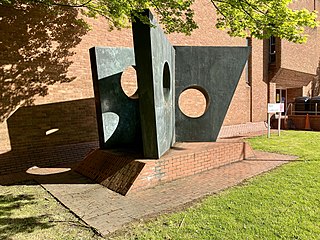
Three Obliques is a 1968 sculpture by Barbara Hepworth. Three casts exist; two are in private collections and a third is displayed outside the Cardiff University School of Music in Cardiff, Wales. It is cast in bronze on a monumental scale.
John Milne (1931–1978) was an English abstract sculptor who worked mainly in bronze and wood but also aluminium and stone. A prominent member of the St Ives group of artists, he was a pupil and worked as an assistant to Barbara Hepworth for two years.



















